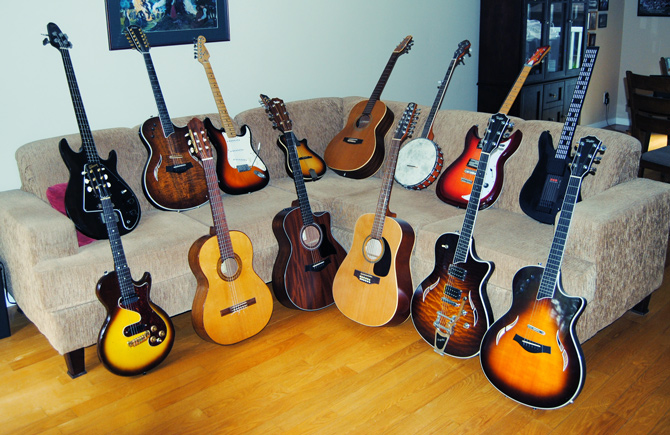This project has been circling in my head for years. For a long time, I’ve admired several guitarists who choose to record in a “B3 trio” format, i.e. electric guitar, Hammond B3 organ and drums. A piece played by only three instruments obviously represents a challenge but also provides the possibility of attaining a minimalist beauty. A recording like John McLaughlin’s “After The Rain” is a prime example of the heights which a B3 trio can attain. I’ve often wondered what I could do with this format so here are a few examples.
First, the technical stuff – I recorded the guitar parts on my Fender Stratocaster going through Native Instruments’ Guitar Rig 5; the drums were generated by Steinberg’s Groove Agent 3 program, with several of my manual corrections to the MIDI files; I achieved the organ sound by playing my Z6S MIDI guitar through Native Instruments’ Vintage Organs software. I did the recording and mixing on my digital audio workstation, Steinberg’s Cubase Studio 5.
In choosing the B3 trio format to record, I also wanted to showcase pieces from my favourite composers, something new since I’ve never recorded any compositions other than my own. Also, my favourite composers tend to work in the jazz field while my guitar roots are in Chicago Blues and 60’s Rhythm & Blues. As a teenager, I particularly loved instrumental groups like The Shadows (Apache, The Rise and Fall of Flingle Bunt) and The Ventures (Telstar, Walk Don’t Run). Consequently, my interpretations of these pieces have a strong R&B flavour.
There are four recordings in this first instalment, which total more than 25 minutes of music. I’ll follow up with more recordings in this B3 trio format as time will allow. Here are the pieces:
This music is protected and any commercial use is strictly forbidden.
On Stream
Composed by Nils Petter Molvær
Published by ECM Records
The Norwegian trumpet player Nils Petter Molvær plays music that combines several genres to create a sound that is entirely his own. I had the priviledge of seeing him live and his group projects a wall of sound, sometimes overwhelming, sometimes transparent, continuously morphing throughout the entire concert, giving form to his pieces like air gives form to clouds. Like all my favourite composers, he’s a leader, not a follower. “On Stream” comes from his 1997 recording entitled “Kmer.” Click on the arrow below to hear the piece.
On Stream
The American guitarist Bill Frisell has been creating music for more than 30 years. He’s at home with several styles and his compositions showcase a particular intimacy with tonalities and their correlation. Frisell has recorded « Strange Meeting » many times but never the same way twice! Click on the arrow below to hear the piece.
Strange Meeting
[audio:http://eng.richardaseguin.com/wp-content/uploads/2013/05/Strange-Meeting.mp3|titles=Strange Meeting]Compare with one of several original recordings of this piece:
Deep as Love
Composed by Tord Gustavsen
Published by ECM Records
A piece taken from Gustavsen’s first ECM recording in 2003. This young Norwegian pianist’s compositions show a surprising maturity. His recording of « Deep as Love » is in the best tradition of those passionate compositions put out by several of the classic American jazz trios (piano, doublebass, drums); my recording is all blues and R&B. Click on the arrow below to hear the piece.
Deep as Love
[audio:http://eng.richardaseguin.com/wp-content/uploads/2013/05/Deep-as-Love.mp3|titles=Deep as Love]Compare with the original recording:
http://www.youtube.com/watch?v=bf-n9qTsjiA
The Lonesome Death of Hattie Carroll
Composed by Bob Dylan
Published by Sony Music Entertainment
Everyone knows Dylan. He wrote « The Lonesome Death of Hattie Carroll » in 1964, following a 1963 incident where William Zantzinger, one of Baltimore’s young elite, killed Hattie Carroll, a 51 year-old waitress and mother of 11. Found guilty of murder, three judges fined him $500 and gave him a 6-month prison sentence, which was delayed by three months so he could bring in his tobacco crop. It was with compositions like this that Dylan became a leading figure in the 60s cultural revolution. Click on the arrow below to hear the piece.
The Lonesome Death of Hattie Carroll
Compare with the original recording:
